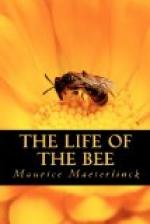And whom does the queen-bee obey? She is ruled by nourishment given her; for she does not take her own food, but is fed like a child by the very workers whom her fecundity harasses. And the food these workers deal out is nicely proportioned to the abundance of flowers, to the spoil brought back by those who visit the calyces. Here, then, as everywhere else in the world, one part of the circle is wrapped in darkness; here, as everywhere, it is from without, from an unknown power, that the supreme order issues; and the bees, like ourselves, obey the nameless lord of the wheel that incessantly turns on itself, and crushes the wills that have set it in motion.
Some little time back, I conducted a friend to one of my hives of glass, and showed him the movements of this wheel, which was as readily perceptible as the great wheel of a clock; showed him, in all its bareness, the universal agitation on every comb, the perpetual, frantic, bewildered haste of the nurses around the brood-cells; the living gangways and ladders formed by the makers of wax, the abounding, unceasing activity of the entire population, and their pitiless, useless effort; the ardent, feverish coming and going of all, the general absence of sleep save in the cradles alone, around which continuous labour kept watch; the denial of even the repose of death in a home which permits no illness and accords no grave; and my friend, his astonishment over, soon turned his eyes away, and in them I could read the signs of I know not what saddened fear.
And truly, underlying the gladness that we note first of all in the hive, underlying the dazzling memories of beautiful days that render it the storehouse of summer’s most precious jewels, underlying the blissful journeys that knit it so close to the flowers and to running water, to the sky, to the peaceful abundance of all that makes for beauty and happiness—underlying all these exterior joys, there reposes a sadness as deep as the eye of man can behold. And we, who dimly gaze on these things with our own blind eyes, we know full well that it is not they alone that we are striving to see, not they alone that we cannot understand, but that before us there lies a pitiable form of the great power that quickens us also.
Sad let it be, as all things in nature are sad, when our eyes rest too closely upon them. And thus it ever shall be so long as we know not her secret, know not even whether secret truly there be. And should we discover some day that there is no secret, or that the secret is monstrous, other duties will then arise that, as yet, perhaps, have no name. Let our heart, if it will, in the meanwhile repeat, “It is sad;” but let our reason be content to add, “Thus it is.” At the present hour the duty before us is to seek out that which perhaps may be hiding behind these sorrows; and, urged on by this endeavour, we must not turn our eyes away, but steadily, fixedly, watch these sorrows and study them, with a courage and interest as keen as though they were joys. It is right that before we judge nature, before we complain, we should at least ask every question that we can possibly ask.




